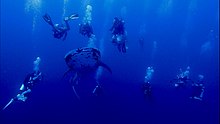Sharkbook
| Legal status | nonprofit |
|---|---|
| Purpose | Online citizen science database to identify and track sharks, in particular whale sharks |
Parent organization | Marine Megafauna Foundation, WildMe |
Volunteers | 9445 citizen scientists, 313 researchers |
| Website | https://www.sharkbook.ai |
Formerly called | whaleshark.org, wildbook for whale sharks |
Sharkbook is a global database for identifying and tracking sharks, particularly whale sharks, using uploaded photos and videos.In addition to identifying and tracking sharks, the site allows people to "adopt a shark" and get updates on specific animals.
Creation
[edit]Sharkbook is the result of collaboration between Simon J Pierce of the Marine Megafauna Foundation and Jason Holmberg of Wild Me. The software is Open Source and is now being used by other biology projects.[1][2][3]

Identification of individual sharks
[edit]Whale sharks have unique spot patterning on their sides, similar to a human fingerprint, which allows for individual identification. Scuba divers around the world can photograph sharks and upload their identification photographs to the Sharkbook website, supporting global research and conservation efforts.[4][5][6][7][8] Additionally, the software automatically searches social media sites like YouTube and Instagram to look for images of whale sharks and adds them to the database.[2]
Sharkbook software uses special pattern-matching software to identify the unique spots on each shark. This software and algorithms were originally adapted from NASA star tracking software[2] used on the Hubble Space Telescope.[3][9] This software uses a scale-invariant feature transform (SIFT) algorithm, which can cope with complications presented by highly variable spot patterns and low contrast photographs.[4][10][11]
Purpose
[edit]This citizen science tool is free to use by researchers worldwide. Sharkbook represents a global initiative to centralize shark sightings and facilitate research on these vulnerable species.[12][13][14][15]
See also
[edit]- Manta Matcher - For Manta Rays
- Flukebook - For whales and dolphins
References
[edit]- ^ Davis, Jessica (2021-06-29). "How a Wildlife AI Platform Solved its Data Challenge". InformationWeek. Retrieved 18 November 2024.
- ^ a b c "How A.I. is helping to protect the endangered whale sharks of the Galapagos". Fortune. Retrieved 2023-02-09.
- ^ a b "How artificial intelligence is changing wildlife research". National Geographic. 2018-11-13. Archived from the original on February 23, 2021. Retrieved 2023-02-10.
- ^ a b Marshall, A. D.; Pierce, S. J. (April 2012). "The use and abuse of photographic identification in sharks and rays". Journal of Fish Biology. 80 (5): 1361–1379. doi:10.1111/j.1095-8649.2012.03244.x. PMID 22497388.
- ^ Weintraub, Karen (2017-11-29). "Tracking the Elusive Whale Shark". The New York Times. ISSN 0362-4331. Retrieved 2023-02-10.
- ^ "Tracking the Sea's Gentle Giants". National Geographic. 2016-11-11. Archived from the original on May 28, 2022. Retrieved 2023-02-10.
- ^ "Nature up close: Whale sharks". CBS News. 21 October 2016. Retrieved 2023-02-10.
- ^ McCoy, Emer; Burce, Raul; David, David; Aca, Elson Q.; Hardy, Jennifer; Labaja, Jessica; Snow, Sally J.; Ponzo, Alessandro; Araujo, Gonzalo (2018). "Long-Term Photo-Identification Reveals the Population Dynamics and Strong Site Fidelity of Adult Whale Sharks to the Coastal Waters of Donsol, Philippines". Frontiers in Marine Science. 5. doi:10.3389/fmars.2018.00271. ISSN 2296-7745.
- ^ "🔭 The Hubble Telescope could help save the world's largest fish". Warp News. 2021-03-01. Retrieved 2023-02-12.
- ^ "Scientists are using cloud computing and AI to track these mysterious, beautiful whale sharks". ZDNET. Retrieved 2023-02-10.
- ^ Russell, Mark 'Crowley' (2022-03-21). "Study shows need for whale shark population monitoring". DIVE Magazine. Retrieved 2023-02-10.
- ^ Stacey, Adrian (2020-05-20). "Dive Photos Needed | Scuba Diver Mag". Retrieved 2023-02-09.
- ^ "Whale shark sightings increase in Tampa Bay area (w/video)". Tampa Bay Times. Retrieved 2023-02-10.
- ^ "22 years and counting – the two whale sharks calling Ningaloo home". Australian Geographic. 2016-10-12. Retrieved 2023-02-10.
- ^ Araujo, Gonzalo; Agustines, Ariana; Tracey, Brian; Snow, Sally; Labaja, Jessica; Ponzo, Alessandro (2019-11-20). "Photo-ID and telemetry highlight a global whale shark hotspot in Palawan, Philippines". Nature. 9 (1): 17209. Bibcode:2019NatSR...917209A. doi:10.1038/s41598-019-53718-w. ISSN 2045-2322. PMC 6868279. PMID 31748588.
